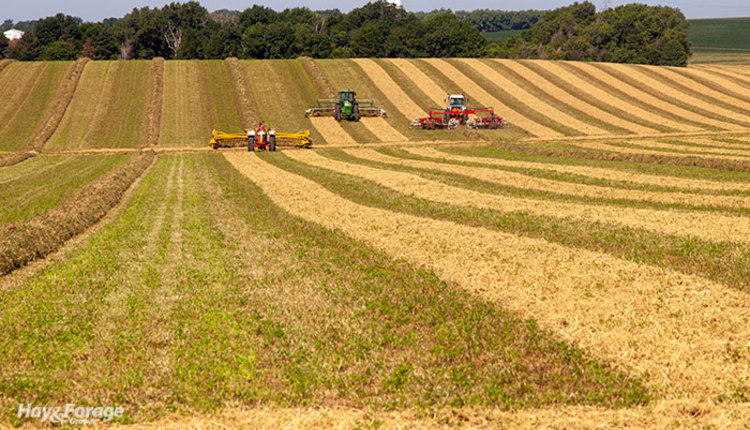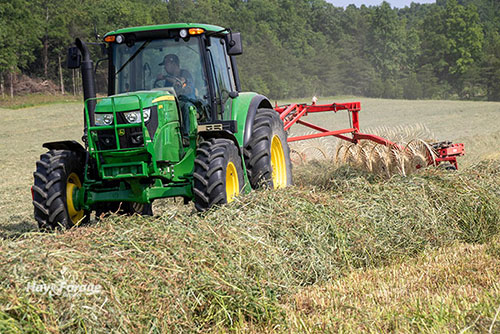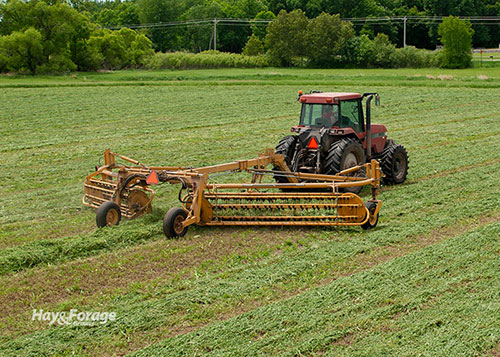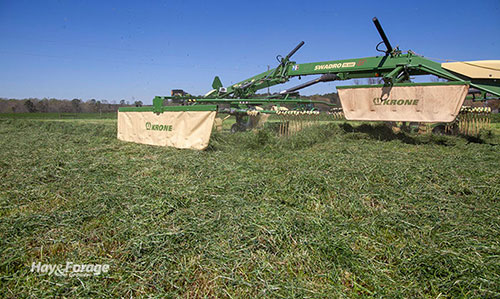It’s the “other” haymaking tool |
| By Mike Rankin, Managing Editor |
|
|
 Let’s face it: When it comes to making hay, the cutter, baler, and forage harvester get most of the glory and attention. But on many operations, there is also the all-important step of raking. Used improperly or at the wrong time, the hay rake can turn an exceptional quality crop into an average or poor one. Although the merger has replaced the need for a hay rake on some forage operations, raking remains a vital haymaking step on most farms. Whenever I’m on a farm, I usually look for or ask about the producer’s rake preference. It’s interesting to note the varying opinions about which type of hay rake is the best. For some, the preferred hay rake type is simply a cost and speed decision; for others, there are strong sentiments on performance. Truthfully, cost, speed, and performance are all legitimate reasons for selecting a hay rake. Each farm presents a situation where the “best rake” answer might be different, and sometimes there may be the need to compromise where different situations are presented on the same farm but only one type of rake is used. The rake that works best will vary with land topography, the type of forage being harvested, windrow or swath orientation, and the moisture in the forage being raked. With all of this in mind, let’s take a closer look at the different hay rake options and outline some of their advantages and disadvantages. Wheel rake  Wheel rakes are the most common and popular type of rake in the U.S. Generally, they are also the lowest cost rake type because there is no power take-off (PTO) or hydraulics needed to drive the raking mechanism. These rakes operate best in dry hay and come in a variety of configurations and sizes: mounted, single frame, twin frame, hydraulic folding option, wheels in front of the frame, wheels behind the frame, and large diameter wheels. One universal complaint I hear about wheel rakes is that they tend to “rope” the windrow. This can slow the drying rate. In the arid West, where hay is dried to a below optimum moisture and then allowed to rewet with external dew, windrow roping is less of a concern from a drying perspective. Proper tension on the individual rake wheels is critical when setting up a wheel rake for operation. The crop must be picked up, but, at the same time, tines need to be set so as not to cause excessive wear and incorporate soil into the windrow. In a three-state study comparing rake types, the wheel rake resulted in the greatest ash content postraking compared to other rake types. Improvements in tine configurations with improved lifting capabilities have recently come onto the market, which has continued to allow for the wheel rake to remain a popular choice for many haymakers. Parallel-bar rake  Parallel-bar rakes, which are sometimes called basket rakes, have been used on farms for many years and still remain popular today. This type of rake has a gentle raking action with a lower chance of soil contamination than the wheel rake. Where wet hay is being raked for chopping or baleage, the parallel-bar rake is often preferred over a wheel rake. Most newer models are hydraulically driven so that ground contact isn’t needed as a power source. A parallel-bar rake will cost more than a similarly sized wheel rake. Parallel-bar rakes are offered in single and twin configurations. Newer designs have larger baskets and more bars (seven versus five) than some of the older models. This allows for more flexibility in making a windrow. Rotary rake  The rotary rake originated in Europe to handle wetter grass forage. It is now a popular choice in the U.S. for windrowing higher-moisture forage. Comparatively speaking, this is generally the most expensive rake type option. Rotary rakes come in a variety of configurations, ranging from one to six rotors. Users like these rakes because they leave a fluffy windrow, allowing for good air movement and drying. Rotor settings and ground speed need to be properly synchronized to avoid shattering leaves from the stem. As with the other types of rakes, tines need to be properly set as to not dig into the ground. Depending on the unit’s configuration, it’s possible to make a single or double windrow. Maintenance and repair costs will typically be higher than with wheel or parallel-bar rakes because of a more extensive drive mechanism. The right choice Over the years, all of these rake types have improved in terms of performance. The possible working width of rakes has also grown. Although newer model rakes are easier than ever to adjust for optimum performance, taking the time and effort to ensure those adjustments are made still largely impacts the final forage quality. Also, the time at which hay is raked is an important decision. For example, raking an already dry alfalfa crop will result in significant leaf loss, regardless of rake type. Differing opinions will always exist as to the best type of rake to buy. When considering the purchase of a new rake, talk to other producers who are making hay or haylage under similar conditions as you. Also, consider dealer support and knowledge of their products. |
